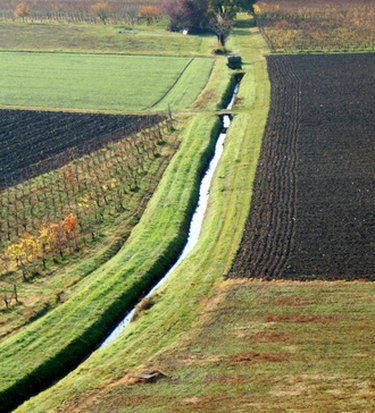
Drip and flood irrigation are two watering methods employed by farmers and gardeners. The irrigation method used is determined by the types of plants requiring irrigation and the location of the field or garden. Drip irrigation transports water to plants in a slow, controlled system while flood irrigation uses gravity to control the flow of water through furrows dug next to plants.
History
Video of the Day
Flood irrigation can be traced to ancient Egypt. Egyptians built canals to transport water from the Nile River to their fields, which were then flooded with the water. Ancient forms of drip irrigation involved burying water-filled clay pots next to plants. The water from the pots would seep into the soil and water the plants. In the late 1800s, Afghanistan farmers used clay pipes to distribute water to plants. This early form of drip irrigation gave way to perforated pipe, invented in the 1920s. It was later replaced by plastic pipe.
Video of the Day
Differences
Flood irrigation is a simple and inexpensive process of directing water down furrows located next to plantings. The water floods the area around the plant and soaks into the soil. Flood irrigation is one of the most popular irrigation methods used today. Drip irrigation is the slow application of water to plants through plastic pipes. The pipes are either laid directly on the soil next to the plants or buried underneath the soil.
Benefits
Drip irrigation systems are beneficial to plants that are in sandy soil and require frequent watering. Plants along steep slopes and in windy locations are ideally suited for drip systems, which reduce runoff and evaporation. Flood irrigation is good for sediment-rich water that clogs the pipes in a drip irrigation system. Plants that require large amounts of water, such as rice, benefit more than other plants from flood irrigation. Clay soils have a low infiltration rate and are suitable for flood irrigation.
Considerations
Drip irrigation systems direct water through pipes that release the water directly on or over plant roots, reducing waste from water runoff and evaporation. Drip systems are an efficient watering system that can be automated to control the amount of water released. Flood irrigation is a basic process that requires minor setup and expense. The runoff waste from flood irrigation can be controlled through field leveling, capturing the runoff for reuse or releasing water at specific times.
Disadvantages
While drip systems are generally considered more efficient and less prone to waste than flood irrigation, they have a few disadvantages. Drip systems are expensive, especially for initial setup. They can clog frequently, too, and plant roots can develop improperly if the drip system is not set up properly. Despite being a popular irrigation method, flood irrigation is not an efficient method for conserving water. When using flood irrigation, at least 1/2 of the water is lost to runoff and evaporation.
- Water Encyclopedia: Irrigation Systems, Ancient
- U.S. Geological Survey: Irrigation Techniques
- Food and Agriculture Organization of the United Nations: Irrigation Water Management: Irrigation Methods--Choosing an Irrigation Method
- Oregon State University: Drip Irrigation: An Introduction; Clinton C. Shock
- Colorado State University Extension: Drip Irrigation for Home Gardens